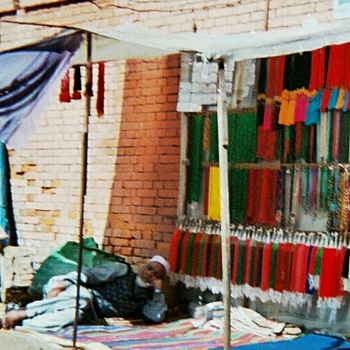| |
Friday,
November 14
A moment in Pokhara
Pokhara is a very laid back
place compared to Kathmandu. The tourist section is mainly
along the road beside the beautiful lake. Shops, restaurants,
and internet cafes line the road. One of the shops belongs
to Krishna, Rob's friend and our guide to be for the trek.
It's one of many shops in a basic shelter type of building,
more like a garage than a shop. In the back they can cook,
but I did not see on what. The walls are hung with backpacks
and trekking gear for sale, knock offs of the expensive brands,
but we didn't see them sell much. There are many many such
shops along the road.
Krishna is 30ish, with a great
smile and laugh. He speaks English fairly well, and he was
delighted to see Rob. The next morning, with the white peaks
of the Annapurnas looming in the distance, we gathered to
finalize the details of the trek. The morning had started
with roosters crowing at 4:00 AM, hours before dawn. And I
had gone for a walk at dawn to watch the town awaken. Later
we gathered and went to the shop. Even though we had already
had breakfast (oat porridge for me) on the big second floor
balcony at the hotel, Krishna insisted on feeding us breakfast
of tea with ginger, toast, eggs, and curried potatoes. We
sorted out the logistics and the equipment.
Later Rob, Andy, and I rented
a boat, rowed across the lake, and climbed up to the stupa.
It was a spectacular view. On the shore of the lake some men
were repairing one of the wooden boats (sort of a cross between
our rowboat and a canoe) on the bank. They were replacing
the boards that constituted the bottom of the boats, boards
that run side to side. A man would carefully fit one, cutting
it with a handsaw so that the ends exactly fit the shape of
the bottom edges of the sides of the boat, where they were
attached, with nails I think. Then he would cut and fit the
next one. Meanwhile two women nearby were twisting cotton
fibers, like cotton swab material, into a long rope. This
was then used to caulk between the boards on the bottom of
the boat. They must have sealed the whole thing with something
after we left. But anyway, hand tools are much more prevalent
in Nepal. I don't think I ever heard the song of a power saw.
The
next day
this
travelogue is part of the subside
travelzine
about bookshelf
links contact
submit
|
|
